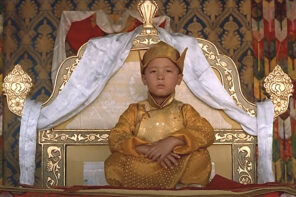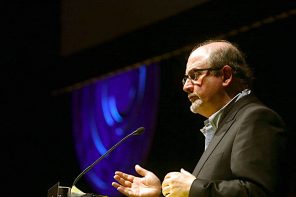The “Religious Literacy Dictionary” in Stephen Prothero’s 2007 bestseller, Religious Literacy, devotes less than two pages to “Buddhism,” but spends seven lines making the point that “Buddhists have not been particularly active in American politics.” This notion, accurate or not, is probably the perception of most Americans, many of whom have little real awareness of the 2,500-year-old tradition to begin with. It may also explain why President Obama’s 25-member Advisory Council on Faith-based and Neighborhood Partnerships (which just launched its official Web site) currently lacks a Buddhist representative, despite the presence of at least one appointee from the other four major world religions.
That said, it bears mentioning that Buddhists have been conspicuously absent from many of the administration’s conversations about and efforts around religion in America. We were not included, for example, in President Obama’s inaugural address, which was addressed to “Christians, Jews, Muslims, Hindus, and non-believers.” In response, the noted scholar-practitioner Robert Thurman quipped at a City & Arts Lectures event in San Francisco that perhaps the Commander-in-Chief was including Buddhists, who don’t always fit into traditionally theistic models of religion, among the “non-believers.” This might be true, but I’d like to advance a case for including Buddhists more explicitly in the Oval Office’s work with religious organizations and services.
Admittedly, we Buddhists in America are few when compared with our sisters and brothers from, say, the Judeo-Christian religious traditions; the Pew Forum on Religion & Public Life’s U.S. Religious Landscape Survey found that those who identify as Buddhist comprise 0.7% of the US population. Still, according to the think tank’s findings, of the five major world religions, Buddhism has the third largest following in the United States, with more adherents than Islam and Hinduism. In addition, Buddhist Americans comprise an incredibly unique and vibrant population—so much so that Los Angeles, for example, has become, as Harvard Divinity School’s Diana L. Eck has noted, “the most complex Buddhist city in the entire world.”
When you think about it, we have also left a remarkable legacy of offerings for our fellow Americans, both Buddhist and non-Buddhist. Consider, for example, the many temples and centers that serve as important hubs of religious education, spirituality, and community in and around large ethnic enclaves throughout the country, such as those under the purview of the Buddhist Churches of America or the Buddhist Council of New York. Consider Naropa University, the Institute of Buddhist Studies, University of the West, and Soka University of America—the four fully-accredited, Buddhist-affiliated, degree-granting institutions of higher education in the United States.
Consider the Insight Meditation Society, the San Francisco Zen Center, and Shambhala Mountain Center, each of which attract thousands of visitors every year for programs of contemplative practice and study. Consider Maitri Compassionate Care in San Francisco, a very early North American AIDS hospice established by the late Issan Dorsey of the Hartford Street Zen Center. Consider the Prison Dharma Network and the National Prison Hospice Association, both founded by Sensei Fleet Maull of the Zen Peacemaker Order.
Consider the Ikeda Center for Peace, Learning, and Dialogue at Cambridge, founded by Daisaku Ikeda, president of Soka Gakkai International. Consider the Bay Area-based Buddhist Peace Fellowship, which mobilizes dozens of chapters and thousands of members around important social and political issues. Consider publications like Tricycle: The Buddhist Review and Shambhala Sun (for whom I blog) that have found appeal beyond just their target demographic.
Consider the work of Buddhists in professional chaplaincy, which has been explored in recent articles in both the New York Times and Los Angeles Times. Consider the newly founded, New York-based Buddhist Global Relief, whose mission is to “provide relief to the poor and needy throughout the world regardless of nationality, ethnicity, gender, or religion.” These are but a very few examples of the incredible work of Buddhists in America. A Buddhist representative on the Council on Faith-based and Neighborhood Partnerships, then, seems quite appropriate, given that it is an initiative tasked with “[forming] partnerships… to more effectively serve Americans in need.”
It is worth mentioning too that Buddhist practices and ideas have begun to leave an indelible impression on the culture at large. Of special note, many non-Buddhist Americans have found the tradition’s teachings and tools helpful in their pursuit of better mental health. The historical Buddha, who abandoned a life of opulence and privilege in order that he might better understand the workings of his own mind and experience true spiritual awakening, once said simply, “I teach only suffering and the end of suffering.” So profound were his insights and those of his interlocutors throughout the ages, however, that modern psychologists and other caring professionals, particularly those in the United States, have found great utility in them. The emergence of such treatments as mindfulness-based stress reduction (MBSR), mindfulness-based cognitive therapy (MBCT), and dialectical behavior therapy (DBT), as well as further developments in other cognitive and behavioral therapies, owe much to Buddhist understanding. There is also a great deal of anecdotal evidence to support claims about the growing influence of the tradition in caregiving and counseling generally. I find it telling, for example, that HBO, as part of a recent documentary produced to promote their psychotherapy-centered series In Treatment, made it a point to include Buddhist psychologist Mark Epstein alongside notable Freudians, Jungians, and others representing more traditional schools of thought in the field.
Additionally, the medical industry’s growing appreciation of Buddhist mindfulness practice (or, the training of the mind to become more aware of the present moment without investment in evaluative thinking and the compulsion to jump from discursive thought to discursive thought) has had a marked effect on the treatment of stress, chronic pain, and other health issues in the United States. In 2007, the National Center for Complementary and Alternative Medicine, one of the National Institutes of Health, found that more than 20 million Americans had used meditation techniques derived from Buddhist or Hindu traditions for various health reasons in the previous twelve months. Furthermore, in a USA Today article published this past summer, Jon Kabat-Zinn, Professor of Medicine Emeritus and founding director of the Stress Reduction Clinic and the Center for Mindfulness in Medicine, Health Care, and Society at the University of Massachusetts Medical School, was quoted as saying that there are now more than 240 programs in clinics and hospitals across the country that offer some kind of program in mindfulness meditation instruction.
By running tests on and studies of longtime monastic practitioners, neurologists like the University of Wisconsin’s Richard Davidson are also beginning to scientifically verify Buddhist claims like that of the eighth-century pundit Shantideva: “All the suffering in the world comes from seeking pleasure for oneself; all the happiness in the world comes from seeking pleasure for others.” In addition to discovering something about the nature of happiness from them, scientists are learning more about neuroplasticity, or ongoing brain development, by studying Buddhist contemplatives as well. All of these findings have been striking enough, in fact, to inspire various high-profile conferences and meetings between scientists and Buddhists. In 2005, for example, His Holiness the 14th Dalai Lama of Tibet was invited by the Stanford University School of Medicine to dialogue with a panel of distinguished neuroscientists.
In short, Buddhist Americans and their work should not be overlooked. Indeed, how helpful a Buddhist representative might be on something like the President’s Advisory Council on Faith-based and Neighborhood Partnerships! One hopes that this will be recognized sooner rather than later. To be fair, council members are appointed to one-year terms, which allows for the possibility of lots of diverse participation over time; hopefully, there will be many opportunities in the future for Buddhists to take part. There is certainly no shortage of excellent candidates to choose from—Jack Kornfield of Spirit Rock Meditation Center, Bishop Socho Koshin Ogui of the Buddhist Churches of America, Zenju Earthlyn Manual of the Buddhist Peace Fellowship, Bhante Chao Chu of the Los Angeles Buddhist Union, B. Alan Wallace of the Santa Barbara Institute for Consciousness Studies, Roshi Joan Halifax of the Upaya Zen Center, Bhante Kondanna of the Staten Island Buddhist Vihara, Jan Willis of Wesleyan University, and two-time Colbert Report guest Lama Surya Das are just a few names that come immediately to mind.
President Obama has said:
The particular faith that motivates each of us can promote a greater good for all of us. Instead of driving us apart, our varied beliefs can bring us together to feed the hungry and comfort the afflicted; to make peace where there is strife and rebuild what has broken; to lift up those who have fallen on hard times.
The administration can acknowledge the reality of religious pluralism in America and thusly promote the greater good for all by ensuring that a wide range of religious and non-religious representatives—a wide range that will necessarily include Buddhist Americans—is in dialogue on the Council on Faith-based and Neighborhood Partnerships. Like their sisters and brothers from various other backgrounds, Buddhist Americans clearly have wisdom to bring and important contributions to make to national service efforts.




